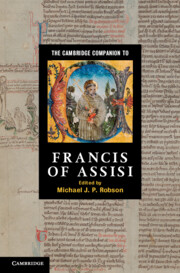Book contents
- Frontmatter
- Introduction
- PART I Francis of Assisi
- 1 Francis and the Franciscan movement (1181/2–1226)
- 2 The writings of Francis
- 3 The Rule and life of the Friars Minor
- 4 Francis and his hagiographical tradition
- 5 Voluntary simplicity: the attitude of Francis towards learning in the early biographies
- 6 Francis and the historiographical tradition in the order
- 7 Francis and Clare and the emergence of the Second Order
- 8 Francis and the encounter with the sultan (1219)
- 9 Francis and creation
- PART II The heritage of Francis of Assisi
- Index
9 - Francis and creation
from PART I - Francis of Assisi
Published online by Cambridge University Press: 28 November 2011
- Frontmatter
- Introduction
- PART I Francis of Assisi
- 1 Francis and the Franciscan movement (1181/2–1226)
- 2 The writings of Francis
- 3 The Rule and life of the Friars Minor
- 4 Francis and his hagiographical tradition
- 5 Voluntary simplicity: the attitude of Francis towards learning in the early biographies
- 6 Francis and the historiographical tradition in the order
- 7 Francis and Clare and the emergence of the Second Order
- 8 Francis and the encounter with the sultan (1219)
- 9 Francis and creation
- PART II The heritage of Francis of Assisi
- Index
Summary
What have they done to the earth?
What have they done to our fair sister?
Ravaged and plundered and ripped her and bit her
Stuck her with knives in the side of the dawn
And tied her with fences
And dragged her down.
Long before contemporary musicians, scientists, theologians and politicians lamented the toxic denigration of the environment, Francis of Assisi displayed a profound empathy for the created world. Not surprisingly, the Roman Catholic Church confirmed the unique rapport of Francis with creation by singling him out as the patron saint of ecology. While the popular image of Francis in nature is often that of a painfully pious, ornamental statue on a bird bath, an examination of his writings and biographies reveals him as the embodiment of Paul's most fervent hope for creation. He writes that all creation groans for the redemption of the children of God, for the material world has been unwillingly subjected to frustration, bondage and decay in the company of humanity. Nature will be set free only if and when humanity is freed in the flesh through the death and resurrection of Christ (Romans 8: 18–27). This chapter first and foremost considers Francis as a harbinger of this eschatological hope, a man whose evangelical conversion draws him into a compassionate, liberating relationship with animate and inanimate creatures alike. Indeed, Francis goes well beyond the Pauline understanding of creation as companion to propose a gendered model of familial equality and freedom in which men and women are joined in prayerful ministry by other creatures, who are all brothers and sisters under one Father in heaven. Following on Francis, we shall then examine the insights of later Franciscans into the nature and significance of creation, especially animals, in salvation history. The writings of Thomas of Celano, Bonaventure of Bagnoregio, Roger Bacon, Duns Scotus and Angela of Foligno provide a compelling witness to the variegated Franciscan appreciation of creation.
- Type
- Chapter
- Information
- The Cambridge Companion to Francis of Assisi , pp. 143 - 158Publisher: Cambridge University PressPrint publication year: 2011
- 1
- Cited by

